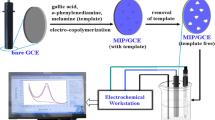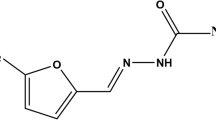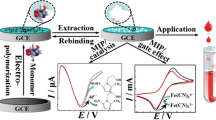Abstract
A novel molecularly imprinted sensor was fabricated and used for the impedimetric detection of melamine. Considering the identity of polymeric film and the pK a of a melamine template, an effective procedure was established to construct the MIP-based melamine sensor. The proposed method is based on the electropolymerization of pyrrole (Py) in the presence of melamine on the electrochemically reduced graphene oxide modified glassy carbon electrode (ERGO/GCE), followed by treatment with the solution of 1% H2O2 in alkaline water/CH3CN-mixed solvents. The surface morphology and the electrical feature of molecularly imprinted polymer (MIP) were characterized by scanning electron microscopy (SEM), Fourier transformation infrared spectroscopy (FTIR), cyclic voltammetry (CV), and electrochemical impedance spectroscopy (EIS). The EIS was also utilized to transduce the change of charge transfer resistance (R ct) at the interface of polymer film-electrolyte, after subsequent incubation of electrode in the solution containing different concentrations of analyte, and consequently, a linear response was obtained over the range of 4.0 to 240 nM with a detection limit of 0.83 nM (S/N = 3). The effect of possible interferences on the response of sensor was studied, and the results confirmed the good selectivity of the proposed device for melamine assay. The MIP sensor was successfully applied to determine melamine in a multiple concentration-spiked milk sample.










Similar content being viewed by others
References
Parizanganeh A, Poorjafari N, Zamani A, Mohseni M (2015) Int J Environ Sci Technol 12:1003–1010
Kim B (2009) Analysis of melamine and cyanuric acid by liquid chromatography with diode array detection and tandem mass spectrometry. Electronic Theses and Dissertations Fogler Library. DigitalCommons@UMaine, The University of Maine, Publication number 3364705.
Tracy M (2010) The mutability of melamine: a transductive account of a scandal (respond to this article at http://www. therai. org. uk/at/debate). Anthropol Today 26:4–8
Dalal RP, Goldfarb DS (2011) Melamine-related kidney stones and renal toxicity. Nat Rev Nephrol 7:267–274
Bretterbauer K, Schwarzinger C (2012) Melamine derivatives—a review on synthesis and application. Curr Org Synth 9:342–356
Yokley RA, Mayer LC, Rezaaiyan R, Manuli ME, Cheung MW (2000) Analytical method for the determination of cyromazine and melamine residues in soil using LC-UV and GC-MSD. J Agric Food Chem 48:3352–3358
Zhu X, Wang S, Liu Q, Xu Q, Xu S, Chen H (2009) Determination of residues of cyromazine and its metabolite, melamine, in animal-derived food by gas chromatography−mass spectrometry with derivatization. J Agric Food Chem 57:11075–11080
Mauer LJ, Chernyshova AA, Hiatt A, Deering A, Davis R (2009) Melamine detection in infant formula powder using near-and mid-infrared spectroscopy. J Agric Food Chem 57:3974–3980
Yang S et al (2009) Detection of melamine in milk products by surface desorption atmospheric pressure chemical ionization mass spectrometry. Anal Chem 81:2426–2436
Lachenmeier DW, Humpfer E, Fang F, Schütz B, Dvortsak P, Sproll C, Spraul M (2009) NMR-spectroscopy for nontargeted screening and simultaneous quantification of health-relevant compounds in foods: the example of melamine. J Agric Food Chem 57:7194–7199
Chen Z, Yan X (2009) Simultaneous determination of melamine and 5-hydroxymethylfurfural in milk by capillary electrophoresis with diode array detection. J Agric Food Chem 57:8742–8747
Guo Z, Gai P, Hao T, Wang S, Wei D, Gan N (2011) Determination of melamine in dairy products by an electrochemiluminescent method combined with solid-phase extraction. Talanta 83:1736–1741
Wang Z, Chen D, Gao X, Song Z (2009) Subpicogram determination of melamine in milk products using a luminol− myoglobin chemiluminescence system. J Agric Food Chem 57:3464–3469
Tittlemier S (2010) Methods for the analysis of melamine and related compounds in foods: a review. Food Addit Contam 27:129–145
Han C, Li H (2010) Visual detection of melamine in infant formula at 0.1 ppm level based on silver nanoparticles. Analyst 135:583–588
Li L, Li B, Cheng D, Mao L (2010) Visual detection of melamine in raw milk using gold nanoparticles as colorimetric probe. Food Chem 122:895–900
Cao Q, Zhao H, Zeng L, Wang J, Wang R, Qiu X, He Y (2009) Electrochemical determination of melamine using oligonucleotides modified gold electrodes. Talanta 80:484–488
Cao Q, Zhao H, He Y, Ding N, Wang J (2010) Electrochemical sensing of melamine with 3, 4-dihydroxyphenylacetic acid as recognition element. Anal Chim Acta 675:24–28
Zhu H, Zhang S, Li M, Shao Y, Zhu Z (2010) Electrochemical sensor for melamine based on its copper complex. Chem Commun 46:2259–2261
Guan-Ping J, Bo Y, Zhen-Xin C, Xiu-Yu C, Ming Z, Chang Z (2011) Electrochemical behaviors and determination of melamine in neutral and acid aqueous media. J Solid State Electrochem 15:2653–2659
Pietrzyk A, Kutner W, Chitta R, Zandler ME, D’Souza F, Sannicolo F, Mussini PR (2009) Melamine acoustic chemosensor based on molecularly imprinted polymer film. Anal Chem 81:10061–10070
Liu YT et al (2011) Electrochemical sensor based on a poly (para-aminobenzoic acid) film modified glassy carbon electrode for the determination of melamine in milk. Electrochim Acta 56:4595–4602
Liang R, Zhang R, Qin W (2009) Potentiometric sensor based on molecularly imprinted polymer for determination of melamine in milk. Sensors Actuators B Chem 141:544–550
Wu B, Wang Z, Zhao D, Lu X (2012) A novel molecularly imprinted impedimetric sensor for melamine determination. Talanta 101:374–381
Huynh T-P, Pieta P, D’Souza F, Kutner W (2013) Molecularly imprinted polymer for recognition of 5-fluorouracil by RNA-type nucleobase pairing. Anal Chem 85:8304–8312
Piletsky S, Piletskaya E, Sergeyeva T, Panasyuk T, El'Skaya A (1999) Molecularly imprinted self-assembled films with specificity to cholesterol. Sensors Actuators B Chem 60:216–220
Haupt K (2001) Molecularly imprinted polymers in analytical chemistry. Analyst 126:747–756
Özcan L, Şahin Y (2007) Determination of paracetamol based on electropolymerized-molecularly imprinted polypyrrole modified pencil graphite electrode. Sensors Actuators B Chem 127:362–369
Sharma PS, Pietrzyk-Le A, D’Souza F, Kutner W (2012) Electrochemically synthesized polymers in molecular imprinting for chemical sensing. Anal Bioanal Chem 402:3177–3204
Vernitskaya TV, Efimov ON (1997) Polypyrrole: a conducting polymer; its synthesis, properties and applications. Russ Chem Rev 66:443–457
Ratautaite V, Janssens SD, Haenen K, Nesládek M, Ramanaviciene A, Baleviciute I, Ramanavicius A (2014) Molecularly imprinted polypyrrole based impedimentric sensor for theophylline determination. Electrochim Acta 130:361–367
Deore B, CHEN Z, NAGAOKA T (1999) Overoxidized polypyrrole with dopant complementary cavities as a new molecularly imprinted polymer matrix. Anal Sci 15:827–828
Ozkorucuklu SP, Sahin Y, Alsancak G (2008) Voltammetric behaviour of sulfamethoxazole on electropolymerized-molecularly imprinted overoxidized polypyrrole. Sensors 8:8463–8478
Leonavicius K, Ramanaviciene A, Ramanavicius A (2011) Polymerization model for hydrogen peroxide initiated synthesis of polypyrrole nanoparticles. Langmuir 27:10970–10976
Kong L, Jiang X, Zeng Y, Zhou T, Shi G (2013) Molecularly imprinted sensor based on electropolmerized poly (o-phenylenediamine) membranes at reduced graphene oxide modified electrode for imidacloprid determination. Sensors Actuators B Chem 185:424–431
Zaidi SA, Shin JH (2014) Molecularly imprinted polymer electrochemical sensors based on synergistic effect of composites synthesized from graphene and other nanosystems. Int J Electrochem Sci 9:4598–4616
Thakur S, Karak N (2015) Alternative methods and nature-based reagents for the reduction of graphene oxide: a review. Carbon 94:224–242
Jorcin J-B, Orazem ME, Pébère N, Tribollet B (2006) CPE analysis by local electrochemical impedance spectroscopy. Electrochim Acta 51:1473–1479
Shamsipur M, Taherpour AA, Pashabadi A (2016) Interrupting the flux of delocalized electrons on a dibenzo-18-crown-6-embedded graphite sheet and its relative counteraction in the presence of potassium ions. Analyst 141:4227-4234
Uygun ZO, Dilgin Y (2013) A novel impedimetric sensor based on molecularly imprinted polypyrrole modified pencil graphite electrode for trace level determination of chlorpyrifos. Sensors Actuators B Chem 188:78–84
Cote LJ, Kim F, Huang J (2008) Langmuir−Blodgett assembly of graphite oxide single layers. J Am Chem Soc 131:1043–1049
Guo H-L, Wang X-F, Qian Q-Y, Wang F-B, Xia X-H (2009) A green approach to the synthesis of graphene nanosheets. ACS Nano 3:2653–2659
Syritski V, Reut J, Menaker A, Gyurcsányi RE, Öpik A (2008) Electrosynthesized molecularly imprinted polypyrrole films for enantioselective recognition of l-aspartic acid. Electrochim Acta 53:2729–2736
Shamsipur M, Pashabadi A, Taherpour AA, Hemmateenejad B, Khosousi T, Parvin MH (2016) Synthesis and characterization of glucose-capped CdSe quantum dots. Electrochemical and computational studies of corresponding carbon-ionic liquid electrode for quantitative determination of minoxidil. J Electroanal Chem 778:116–125
Gupta VK, Yola ML, Özaltın N, Atar N, Üstündağ Z, Uzun L (2013) Molecular imprinted polypyrrole modified glassy carbon electrode for the determination of tobramycin. Electrochim Acta 112:37–43
Schweiger B, Kim J, Kim YJ, Ulbricht M (2015) Electropolymerized molecularly imprinted polypyrrole film for sensing of clofibric acid. Sensors 15:4870–4889
Wolfart F, Dubal DP, Vidotti M, Holze R, Gómez-Romero P (2016) Electrochemical supercapacitive properties of polypyrrole thin films: influence of the electropolymerization methods. J Solid State Electrochem 20:901–910
Alshammary B, Walsh FC, Herrasti P, de Leon CP (2016) Electrodeposited conductive polymers for controlled drug release: polypyrrole. J Solid State Electrochem 20:839–859
Xie C, Li H, Li S, Wu J, Zhang Z (2009) Surface molecular self-assembly for organophosphate pesticide imprinting in electropolymerized poly (p-aminothiophenol) membranes on a gold nanoparticle modified glassy carbon electrode. Anal Chem 82:241–249
Li H, Xie C, Li S, Xu K (2012) Electropolymerized molecular imprinting on gold nanoparticle-carbon nanotube modified electrode for electrochemical detection of triazophos. Colloids Surf B Biointerfaces 89:175–181
Hwang J-H, Pyo M (2007) pH-induced mass and volume changes of perchlorate-doped polypyrrole. Synth Met 157:155–159
Yang J, Deng S, Lei J, Ju H, Gunasekaran S (2011) Electrochemical synthesis of reduced graphene sheet–AuPd alloy nanoparticle composites for enzymatic biosensing. Biosens Bioelectron 29:159–166
Wang Y, Sotzing GA, Weiss R (2008) Preparation of conductive polypyrrole/polyurethane composite foams by in situ polymerization of pyrrole. Chem Mater 20:2574–2582
Thombare J et al. (2013) Studies on electrochemically synthesized polypyrrole (Ppy) thin films for supercapacitor application. Conference in: Energy efficient technologies for sustainability (ICEETS), International Conference on. IEEE, 1064–1067
Harvey D (2000) Modern analytical chemistry, vol 381. McGraw-Hill, New York
Miller JC, Miller JN (1988) Statistics for analytical chemistry. John Wiley and Sons, New York
Yu J, Zhang C, Dai P, Ge S (2009) Highly selective molecular recognition and high throughput detection of melamine based on molecularly imprinted sol–gel film. Anal Chim Acta 651:209–214
Muñiz-Valencia R, Ceballos-Magaña SG, Rosales-Martinez D, Gonzalo-Lumbreras R, Santos-Montes A, Cubedo-Fernandez-Trapiella A, Izquierdo-Hornillos RC (2008) Method development and validation for melamine and its derivatives in rice concentrates by liquid chromatography. Application to animal feed samples. Anal Bioanal Chem 392:523–531
Wu Y-T et al (2009) Determination of melamine in rat plasma, liver, kidney, spleen, bladder and brain by liquid chromatography–tandem mass spectrometry. J Chromatogr 1216:7595–7601
Hong M et al (2009) Simultaneous determination of melamine, ammelide, ammeline, and cyanuric acid in milk and milk products by gas chromatography-tandem mass spectrometry. Biomed Environ Sci 22:87–94
Rima J, Abourida M, Xu T, Cho IK, Kyriacos S (2009) New spectrophotometric method for the quantitative determination of melamine using Mannich reaction. J Food Compost Anal 22:689–693
Author information
Authors and Affiliations
Corresponding author
Rights and permissions
About this article
Cite this article
Shamsipur, M., Moradi, N. & Pashabadi, A. Coupled electrochemical-chemical procedure used in construction of molecularly imprinted polymer-based electrode: a highly sensitive impedimetric melamine sensor. J Solid State Electrochem 22, 169–180 (2018). https://doi.org/10.1007/s10008-017-3731-z
Received:
Revised:
Accepted:
Published:
Issue Date:
DOI: https://doi.org/10.1007/s10008-017-3731-z




